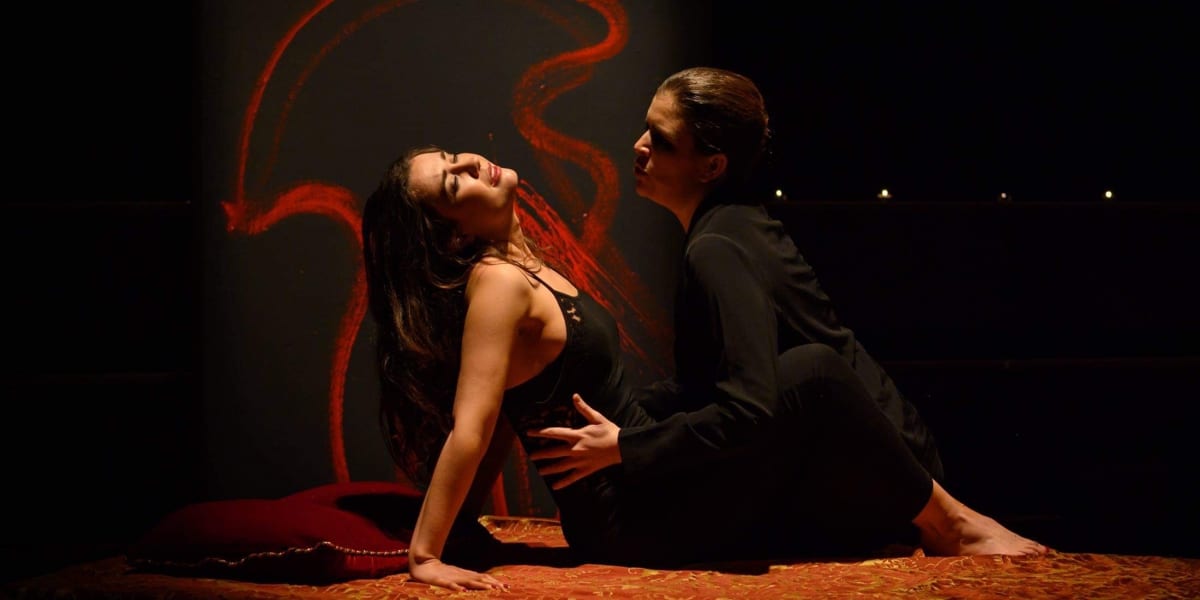This magnificent opera by Monteverdi was first performed at the Venice Carnival in 1643. It dates from the earliest days of opera when composers were pre-occupied with the artistic challenge of creating a musical drama by setting poetry to music in ways that were both ‘naturalistic’ and beautiful. Monteverdi’s musical genius enabled him to lead the way in meeting that challenge and all composers of baroque opera owed him a debt. How lucky are we that the revival of interest in early opera has given rise to Marcio da Silva’s wonderful Ensemble OrQuesta which is offering a version of Poppea that is true to its musical roots and provides a dramatic staging that is entirely contemporary.
The performing space at The Cockpit is large enough to allow for the singers to move freely and to create visual images that enhance the telling of the story but intimate enough to allow the audience, seated in rows on three sides of the space, to feel close up to the action. And what a pleasure that is when we can get so close to fine young singers. And all the scenery that is needed is the bed which Poppea uses to enslave Nero, two chairs and a lit screen at the back – not sure that the occasional blasts of dry ice helped much.
The story is of the triumph of vice over virtue – or perhaps lust over the bonds of matrimony. The ambitious and beautiful Poppea has lured the emperor Nero into her bed and plans to persuade him to divorce his wife Ottavia and install her as queen. The noble Seneca urges Nero not to succumb to his mistress but is rewarded for his efforts by an order to commit suicide. Ottone, whose love has been spurned by Poppea, is reluctantly recruited by a vengeful Ottavia to murder her rival. His plot, aided by the Lady Drusilla, goes awry. In this version Ottone and Drusilla are executed and Ottavia is led away to death while Nero and Poppea are left to celebrate their union. And throughout, the spirits of Virtue and Fortune and Love watch the mortals in their trials and torments, and try to guide their choices.
As Nero and Poppea Helen May and Kathleen Nic Dhiarmada are superb. It is a real triumph to conjure up a passionate affair out of 400 year old words and music. After a hesitant start, May nicely catches the difficult balance between autocratic emperor and lovestruck suitor and, in a role that would probably have originally been sung by a castrato, she makes a convincing male hero. Nic Dhiarmada is born for Poppea. Her rich soprano voice copes well with the twist and turns of Monteverdi’s music. The famous final duet between the two of them is spell binding. Indeed, the final few scenes are the best of the opera as all the singers – some of whom were slow to catch the baroque idiom in their early appearances – settled to the style. All credit then to Marcio Da Silva, who directed, conducted, played and sang, for creating a team that seemed to ‘get’ the musical language of Monteverdi – so different from the style that most young singers today learn for opera performance.
With so many roles, it seems harsh to choose just one or two for special mention but Sarah Matousek as Amore, Gheorghe Palcu as Seneca and Sophie Levi as Ottavia all impressed. And in the tiny but demanding role of Arnalta, tenor Kieran White delivered the ‘lullaby’ (as Poppea falls asleep just before the assassination attempt) with heart stopping beauty.
The ensemble musicians on various stringed instruments were never less than convincing. Cedric Meyer on archlute was superb. This is a gripping evening from beginning to end and a vindication of the accessibility of Monteverdi’s operas. I hope more and more people have the chance to sample Ensemble OrQuesta and their baroque gems.

